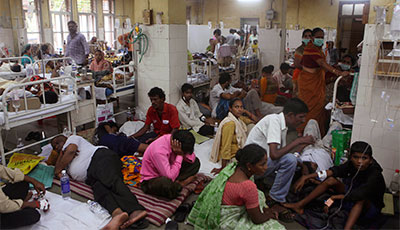Last week, Tarun Sehrawat, a 22-year-old Indian photographer for Tehelka magazine, died from cerebral malaria and its complications, according to several of his colleagues and media accounts. He had returned, ill, from a shooting assignment with Tehelka‘s reporter Tusha Mittal in May. The team had been covering the ongoing Maoist revolt in Chhattisgarh in central India and reported it in “Inside Abujmarh The Mythic Citadel.” Both Sehrawat and Mittal became very ill, but Sehrawat succumbed. Mittal, we understand, is still recovering.
A former Tehelka staffer, Salil Tripathi, posted a comprehensive report, “Young Photographer’s Death Has Some Worried“ on the New York Times‘ blog India Ink today. The post addresses the issue of how media houses help prepare their teams to protect themselves from contracting diseases while covering stories. That’s something CPJ covers in section eight, “Health Epidemics and Mass Hazards,” in the latest edition of CPJ’s Journalist Security Guide. It does a fine job on the basics, and in the aftermath of Japan’s 2011 Tōhoku earthquake and tsunami, even covers radiation threats.
(Tripathi’s post also fills in background on the heavily underreported Maoist uprising Sehrawat and Mittal were covering, and it has an appreciation of Sehrawat and his work. Sehrawat, by all accounts, was a driven photographer but also a decent man who empathized with the subjects he was photographing. Tehelka has posted a retrospective of some of his work.)
I have some experience with the issue of journalists confronting disease threats. As a cameraman for Visnews (now Reuters TV) and later NBC in the early days of my career, I know the risks those on the visual side of journalism take. We tend to get closer to the action than print reporters and the risks tend to run higher–though Tusha Mittal might make a different argument.
After retiring from journalism, I worked for the World Health Organization (WHO) doing risk communication and media relations during disease outbreaks and natural disasters, mostly in Asia. The job gave me daily contact with journalists in the field covering outbreaks like SARS or H1N1 or H5N1, or the many public health threats in the aftermath of the December 2004 tsunami that devastated parts of South and Southeast Asia. I would always take the time to remind journalists that they were not immune to the disease that was killing the people they were reporting on, and I would take particular time to caution camera crews and field producers about getting too close to disease carriers like chickens or swine just to get that telling close-up that they and their editors loved so much. Even if they had had combat experience and felt they knew how to take care of themselves in dangerous situations, they were facing something much more insidious than a double car bomb or a firefight.
By the time of my WHO stint, around 2002 to 2006, some of the crews from developed countries had a modicum of training and equipment to deal with violent conflict, but none that I knew had been prepped for dealing with microscopic viruses or other microbes. Some of the bigger news organizations bought the same sort of protective gear WHO was using in the field–those white coverall suits and face masks. But they hadn’t been trained in how to use them effectively, and we at WHO worried they were given a false sense of security that courted even more danger. WHO staffers were given full training in use of the gear, with frequent review courses in which we put the stuff on and took it off in the correct manner– and kept doing so until the trainers were convinced we knew what we were doing. Camera crews were generally handed the gear and more or less told, “Here, use this, it will protect you.” That’s not good enough.
From the accounts I’ve read, Sehrawat and Mittal fell victim to an endemic form of malaria, one that they should have been aware of, ideally through their own preparation and through Tehelka‘s assignment desk. It’s not the sort of disease that calls for all-out protective gear, but effective precautions can be taken. The impression I’ve formed is that this lesson has been learned; the publicity surrounding Sehrawat’s death has raised the issue across newsrooms in India. That is a good thing.
And the bigger issue hasn’t gone unnoticed, either. Tehelka‘s editor, Tarun Tejpal, has written perhaps the most important story to come out of this: “The Messenger, And The Message: A young Tehelka journalist’s death highlights the dismal state of rural healthcare.” Why are hunger and disease still out of focus? It’s a short, moving, well-argued piece that pays homage to the sort of work the 22-year old Tarun Sehrawat seemed on the path to dedicating his life to.
